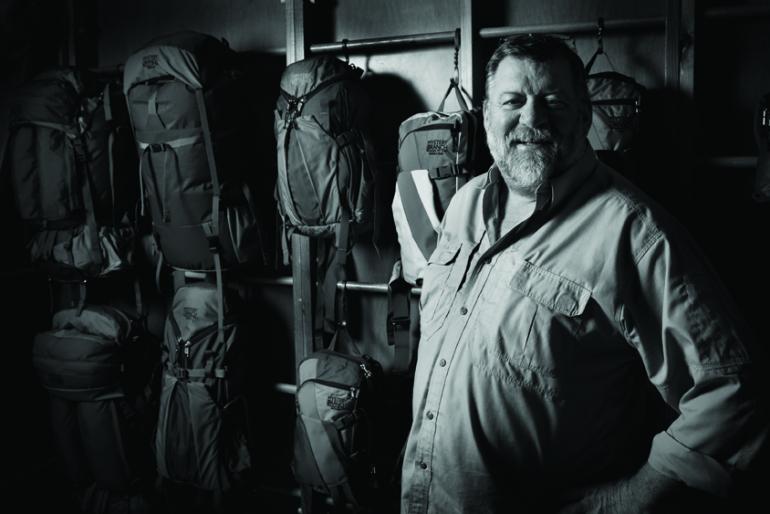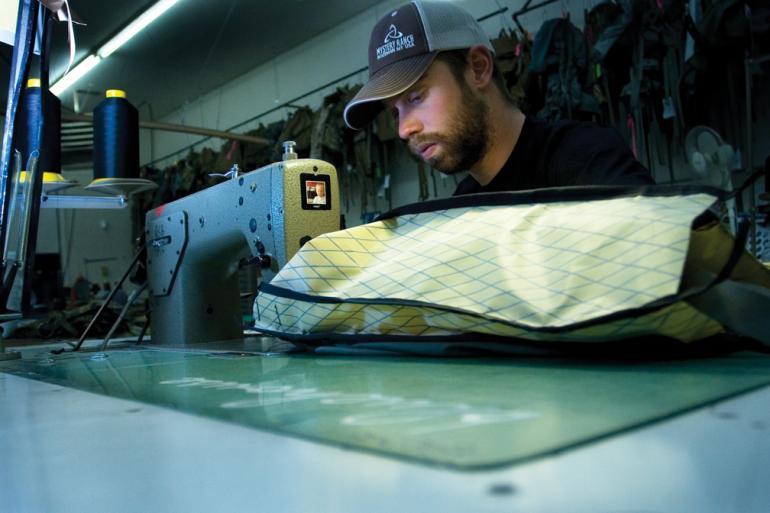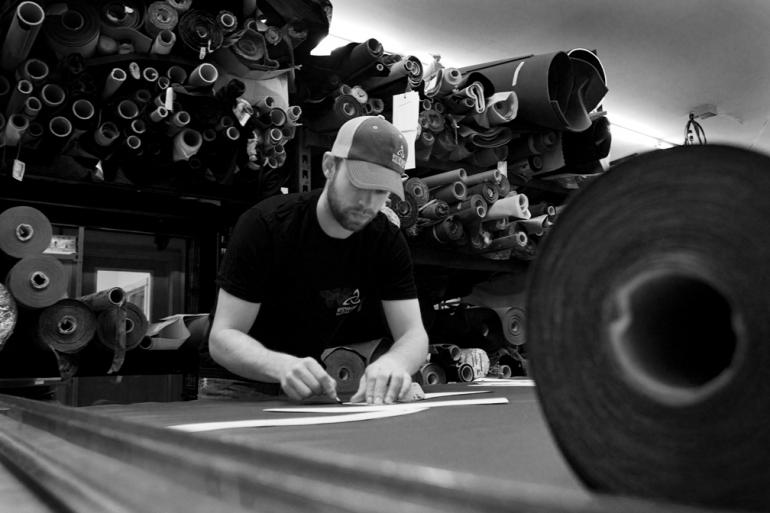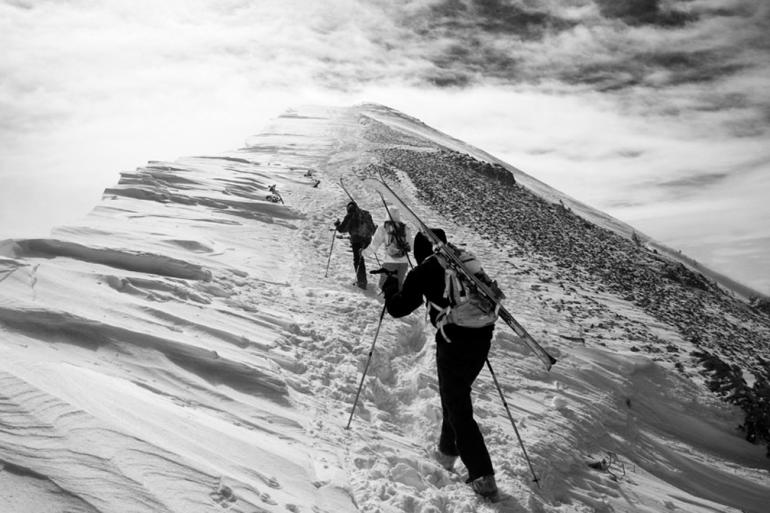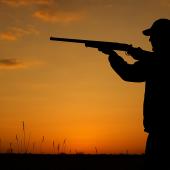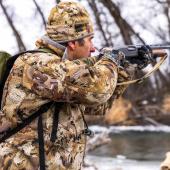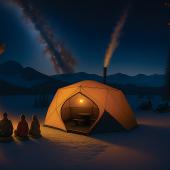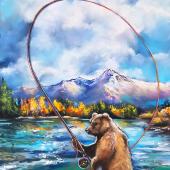Leader of the Pack
Dana Gleason just keeps on truckin'.
After 35 years of making packs, longtime Bozeman local Dana Gleason is busy. And his company–Mystery Ranch–shows no signs of slowing down, ramping up production to meet the massive demand and expanding into new fields. With a dedicated staff, hands-on design, and passionate consumers, creating an outstanding final product becomes “so easy, it’s almost like cheating,” Dana says. And even at 56, Dana himself shows no signs of slowing down, despite the company slowly transitioning into the hands of the next generation working there. “I retired once,” he explains, “but I just didn’t have the moral fiber to make it stick. I’ll probably be at it forever.” And with a hearty chuckle, he adds, “What a long, strange trip it’s been.”
Humble Beginnings
Mystery Ranch’s meteoric rise to a worldwide brand began over three decades ago, when a young Dana Gleason “escaped” Boston and moved out West. By 1975, he’d settled in Bozeman and, within the first week, started his first outdoor company: Kletterwerks. “We wanted it to mean ‘climbing factory’, but it actually ended up meaning ‘rock foundry,’” Dana says with a laugh. “Oh well.”
Over the next few years, Dana learned the basics: building packs, running a company, and making mistakes. Some of his later, more famous packs were actually developed and named at Kletterwerks (“In a monument to our lack of creativity,” he claims), including the Terraplane and the Bomb Pack–which was, according to Dana, “a pack we built for the folks up at Bridger to haul, well, bombs. Can’t get a pack with that name through airport security anymore.”
After selling his share of Kletterwerks to his partners in 1978, he created Mojo Systems, a pack company oriented towards camera and computer bags, which eventually became Quest Systems. Incorporating plastics, synthetics, and fiberglass into the production of different bags, Dana pioneered aspects of pack development that have now become the industry standard. Working with high-end photographers, news teams, and even film crews shooting on Mount Everest, Dana and his design team began creating highly specialized products for their customers–who absolutely needed their gear to work–and began to shape an important principle that would come to heavily influence the philosophies of Mystery Ranch.
Dana Design
In 1985, Dana sold Quest Systems and officially created Dana Design out of his house, co-founded with his longtime business associate Renee Sippel-Baker. “Over a decade ago, we realized how poorly I was at running a company,” Dana admits. Designating Renee “Minister of Internal Affairs,” she created a perfect administrative compliment to Dana’s sales and production talents, allowing the company to grow. As Dana explains it, “I got the fun bits, and she kept the promises.”
By breaking up functions of the pack in areas of stability, load control, and fit, Dana and his team made tremendous steps forward within the backpack industry, and created packs that stood out on the worldwide market. “It was the largest company we’d ever created,” Dana explains. “It got bigger than anything we could have envisioned.” In 1995, Dana decided to sell the company to K2 Corporation in an effort to productively channel their growth. “It worked out reasonably well for a while,” Dana says. “We learned a few things about how companies were actually run.”
Despite making good money with their three Montana production plants, K2 shut down their stateside facilities, moved manufacture overseas, and terminated nearly 300 employees. “K2 was moving all its production offshore–that’s how you save money–and our stuff went offshore as well,” Dana sighs. Unimpressed with how K2 made “corporate sausage,” Renee left the company in 1997. Dana followed in 1999.
“Towards the late ‘90s, I began to think I was sick of building backpacks,” Dana says, and after retiring when he left K2, he spent his time like most Bozemanites: enjoying the outdoors. Spending his free time on trail, he found that his Dana Design packs were very popular, but the majority of people were using poorly fitted, incorrectly sized bags. “It was embarrassing,” he explains. “ Dana realized that to get the full effects of the technology, packs had to be designed so that it would actually be utilized by the everyday user: “It turned out not to be an education problem of the user,” he explains, “but ultimately a design problem. It needed to work correctly, right when you put it on.” And with this revelation, another tenet of Mystery Ranch was born.
Still not sure he would return to the backpack industry, Dana entertained notions of starting a content-based website or a similar Internet business. But then, when his daughter asked him to make a fanny pack for her hiking trips and he created something she absolutely loved, Dana was sucked right back in. “It was at this point I realized I was a one-trick pony,” he laughs. With this renewed vigor, Dana decided to return to the industry one more time.
Mystery Ranch
In 2000, Dana created his fourth pack company: Mystery Ranch. Due to pricing standards within the outdoor gear market, production initially began in China. Fortuitously, in 2003, several Navy SEALs came to Mystery Ranch looking for a version of the Astralplane that K2 wasn’t willing to build them. Dana agreed: “We decided ‘sure, why not.’” Word of their quality packs spread, and by using income generated from different military contracts, Dana was able to bring production back to Montana. “Ultimately, it felt so good to build the gear by ourselves and ensure that it was built right,” Dana says. “We began to question how outdoor gear was sold in the US.” Through relentless markups, he explains, most outdoor gear is originally bought for one-fifth its retail price. By building specialized equipment for core users locally and selling it to them directly, Mystery Ranch has created a bit more of what Dana calls a “naked business transaction.”
Through building packs for the military, Dana and crew found other hardworking groups–wilderness fire fighters, medical workers, and hotshot crews–who needed quality above all else, and thus developed a deep reliance on Mystery Ranch products. “If our packs don’t work for these customers,” Dana notes, “the consequences could be severe. They need what we do.” Ultimately, the Mystery Ranch team adopted the working mantra of “creating tools, not sporting goods,” and production went beyond just creating a pack that carries well. Currently, the majority of packs built by Mystery Ranch are designated for military contracts–including foreign militaries as well. “It’s had a large impact on how we designed our gear,” Dana says.
And as for the name of the company, was there a real Mystery Ranch somewhere? “I wish I had a romantic story for that, but I don’t,” Dana says. “Growing up in Boston, there was a Saturday morning show about a ranch with singing cowboys, solving crime in the Wild West.” Dana laughs and shakes his head. “That gave me the idea, and we needed a name when we were forming the company… a flag to stick in the ground. ‘Mystery Ranch’ is such a non-sequitur that we could trademark it all over the world.”
Keeping it Local
Will production ever move back overseas? Dana doesn’t think so, and for him, staying local comes down to the quality of the product. “This isn’t about wrapping ourselves in the flag,” he says. “We want the absolute best, and that is much easier to guarantee when it’s produced here.” If Mystery Ranch were producing what Dana calls “fashion bags,” then production could feasibly move abroad. But with a strong customer base that places such a heavy reliance on the reliability of the product, they need control at every point of production. “Really, it’s a pain in the ass doing things right every step of the way,” Dana admits. “But it’s worth it.”
When asked about the most integral aspect of Mystery Ranch’s success, almost every employee is in agreement. “We absolutely couldn’t do it without our amazing production staff,” comments Mark Seacat, marketing director for the company. “They’re what make Mystery Ranch so amazing.” After starting at the company as a janitor and living out of his car, Mark worked his way up the ladder, finally heading a sector of the company he created himself. After years at nearly every position in the company, he admits that the most critical one is just sewing the components together. “Selling the packs is easy,” he says, but in the field, “they work miracles.”
And spread out across the expansive production floor sit young, cheery employees more than happy to spend hours running a sewing machine. “I’m really lucky to have found Mystery Ranch,” says Mimi Matusda, one of the many sewers. After falling in love with Bozeman years ago, she finally decided to pack up and move into town—and she found a job making packs for a company she believes in. She agrees that even in the face of demanding, intricate work–sometimes down to the millimeter–Mystery Ranch creates an inviting work environment, composed of outdoorsy people like herself. “It’s like one gigantic family here,” she explains. “Going to work is really a hoot.”
New Location and Products
Faced with a tremendous increase in demand, the company recently packed up and moved into the old Cardinal Distributing warehouse on the way to Bridger Bowl. “Really, we moved for our employees to be closer to the ski hill,” Dana jokes.
The move will add an extra 10,000 feet of workspace, allowing them to expand their staff to just over 100 people. And finding new hires won’t take long: “There’s not a time where I don’t have an inch-thick stack of resumes on my desk,” notes Luke Buckingham, official “Ranch Hand” for Mystery Ranch. “Turnover is nearly non-existent as well.” With production orders booked for the next seven months and every department running out of room, “we’re essentially scaling everything up and increasing the efficiency,” Dana says. “Our current building is fairly cramped and everyone is stacked on top of each other. This will definitely help.”
Among the many innovative projects set for completion in the new building is a Gore-designed Open Country camouflage system for Mystery Ranch’s line of hunting packs. Researchers have found that animals see different colors than humans, with a different set of visual acuities, and have different sensitivity to motion—which renders current camo patterns less effective. “For most of the really cool-looking camos that try to duplicate a background,” explains Dana, their prey is the hunter that’s buying it, not the animals they’re hunting.” Yet another Mystery Ranch principle revealed: function over fashion.
The Future
So with worldwide acclaim, record sales despite a lackluster economy, and 30,000 packs constructed last year alone–each one proudly displaying a “Made in Bozeman, Montana, USA” tag–the future has never been brighter for Dana Gleason and Mystery Ranch.


